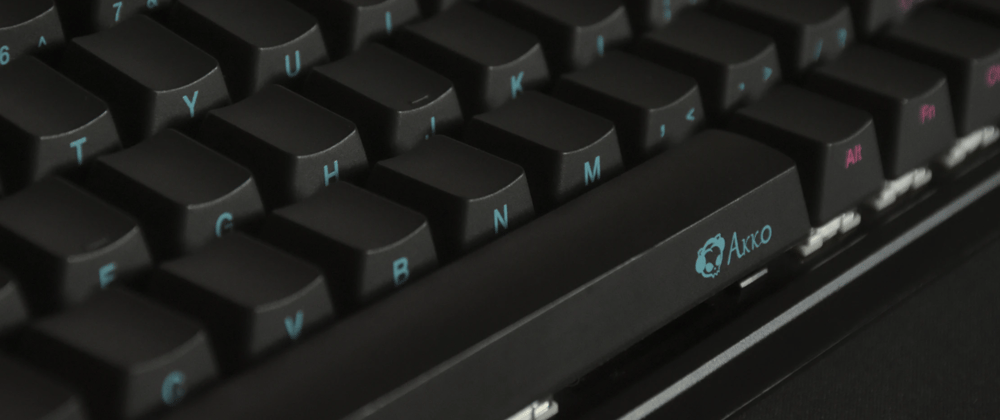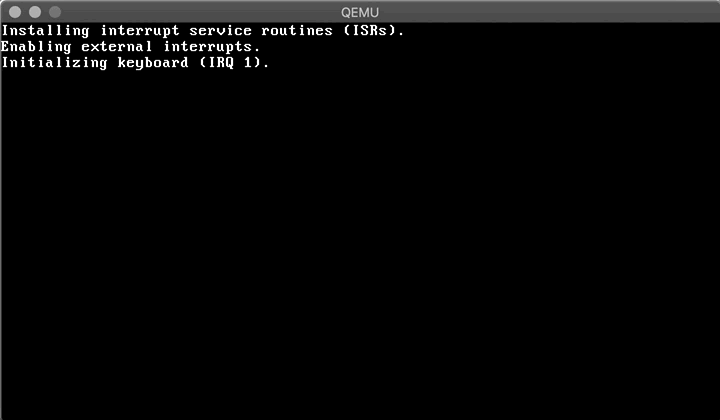Introduction
In the previous post we implemented a video driver so that we are able to print text on the screen. For an operating system to be useful to the user however, we also want them to be able to input commands. Text input and output will be the foundation for future shell functionality.
But how does the communication between the keyboard and our operating system work? The keyboard is connected to the computer through a physical port (e.g. serial, PS/2, USB). In case of PS/2 the data is received by a microcontroller which is located on the motherboard. When a key is pressed, the microcontroller stores the relevant information inside the I/O port 0x60 and sends an interrupt request IRQ 1 to the programmable interrupt controller (PIC).
The PIC then interrupts the CPU with a predefined interrupt number based on the external IRQ. On receiving the interrupt, the CPU will consult the interrupt descriptor table (IDT) to look up the respective interrupt handler it should invoke. After the handler has completed its task, the CPU will resume regular execution from before the interrupt.
For the complete chain to work we need to do some preparations during the kernel initialization. First, we have to setup the correct mapping inside the PIC so that our IRQs get translated to actual interrupts correctly. Then, we must create and load a valid IDT that contains a reference to our keyboard handler. The handler then reads all relevant data from the respective I/O ports and converts it to text that we can show to the user, such as LCTRL or A.
Now that we know the high level overview of what we need to do, let's jump into it! The remainder of this post is structured as follows. The next section focuses on defining and loading the IDT. Afterwards we will implement the keyboard interrupt handler and register it. Last but not least we extend the kernel functionality to execute the newly written code in the correct order.
The source code is available at GitHub. The code examples of this post use type aliases from #include <stdint.h> which are a bit more structured than the original C types. uint16_t corresponds to an unsigned 2 byte (16 bit) value, for example.
Setting Up The IDT
IDT Structure
The IDT consists of 256 descriptor entries, called gates. Each of those gates is 8 bytes long and corresponds to exactly one interrupt number, determined from its position in the table. There are three types of gates: task gates, interrupt gates, and trap gates. Interrupt and trap gates can invoke custom handler functions, with interrupt gates temporarily disabling hardware interrupt handling during the handler invocation, which makes it useful for processing hardware interrupts. Task gates cause allow using the hardware task switch mechanism to pass control of the processor to another program.
We only need to define interrupt gates for now. An interrupt gate contains the following information:
- Offset. The 32 bit offset represents the memory address of the interrupt handler within the respective code segment.
- Selector. The 16 bit selector of the code segment to jump to when invoking the handler. This will be our kernel code segment.
-
Type. 3 bits indicating the gate type. Will be set to
110as we are defining an interrupt gate. -
D. 1 bit indicating whether the code segment is 32 bit. Will be set to
1. -
DPL. 2 bits The descriptor privilege level indicates what privilege is required to invoke the handler. Will be set to
00. -
P. 1 bit indicating whether the gate is active. Will be set to
1. -
0. Some bits that always need to be set to
0for interrupt gates.
The diagram below illustrates the layout of an IDT gate.
To create an IDT gate in C, we first define the idt_gate_t struct type. __attribute__((packed)) tells gcc to pack the data inside the struct as tight as they are defined. Otherwise the compiler might include padding to optimize the struct layout with respect to the CPU cache size, for example.
typedef struct {
uint16_t low_offset;
uint16_t selector;
uint8_t always0;
uint8_t flags;
uint16_t high_offset;
} __attribute__((packed)) idt_gate_t;
Now we can define our IDT as an array of 256 gates and implement a setter function set_idt_gate to register a handler for interrupt n. We will make use of two small helper functions to split the 32 bit memory address of the handler.
#define low_16(address) (uint16_t)((address) & 0xFFFF)
#define high_16(address) (uint16_t)(((address) >> 16) & 0xFFFF)
idt_gate_t idt[256];
void set_idt_gate(int n, uint32_t handler) {
idt[n].low_offset = low_16(handler);
idt[n].selector = 0x08; // see GDT
idt[n].always0 = 0;
// 0x8E = 1 00 0 1 110
// P DPL 0 D Type
idt[n].flags = 0x8E;
idt[n].high_offset = high_16(handler);
}
Setting Up Internal ISRs
An interrupt handler is also referred to as a interrupt service routines (ISR). The first 32 ISRs are reserved for CPU specific interrupts, such as exceptions and faults. Setting these up is crucial as they are the only way for us to know if we are doing something wrong when remapping the PIC and defining the IRQs later. You can find a full list either in the source code or on Wikipedia.
First, we define a generic ISR handler function in C. It can extract all necessary information related to the interrupt and act accordingly. For now we will have a simple lookup array that contains a string representation for each interrupt number.
char *exception_messages[] = {
"Division by zero",
"Debug",
\\ ...
"Reserved"
};
void isr_handler(registers_t *r) {
print_string(exception_messages[r->int_no]);
print_nl();
}
To make sure we have all information available, we are going to pass a struct of type registers_t to the function that is defined as follows:
typedef struct {
// data segment selector
uint32_t ds;
// general purpose registers pushed by pusha
uint32_t edi, esi, ebp, esp, ebx, edx, ecx, eax;
// pushed by isr procedure
uint32_t int_no, err_code;
// pushed by CPU automatically
uint32_t eip, cs, eflags, useresp, ss;
} registers_t;
The reason this struct is so complex lies in the fact that we are going to invoke the handler function (which is written in C) from within assembly. Before a function is invoked, C expects the arguments to be present on the stack. The stack will contain some information already and we are extending it with additional information.
Below is an excerpt of the assembly code that defines the first 32 ISRs. Unfortunately there is no way to know which gate was used to invoke the handler so we need one handler for each gate. We have to define the labels as global so that we can reference them from our C code later.
global isr0
global isr1
; ...
global isr31
; 0: Divide By Zero Exception
isr0:
push byte 0
push byte 0
jmp isr_common_stub
; 1: Debug Exception
isr1:
push byte 0
push byte 1
jmp isr_common_stub
; ...
; 12: Stack Fault Exception
isr12:
; error info pushed by CPU
push byte 12
jmp isr_common_stub
; ...
; 31: Reserved
isr31:
push byte 0
push byte 31
jmp isr_common_stub
Each procedure makes sure that int_no and err_code are on the stack before handing over to the common ISR procedure, which we will look at in a moment. The first push (err_code), if present, represents error information that is specific to certain exceptions like stack faults. If such an exception occurs, the CPU will push this error information to the stack for us. To have a consistent stack for all ISRs, we are pushing a 0 byte in the cases where no error information is available. The second push corresponds to the interrupt number.
Now let's look at the common ISR procedure. It will fill the stack with all information required for registers_t, prepare the segment pointers to invoke our kernel ISR handler isr_handler, push the stack pointer (which is a pointer to registers_t actually) to the stack, call isr_handler, and clean up afterwards so that the CPU can resume where it was interrupted. isr_handler has to be marked as extern, because it will be defined in C.
[extern isr_handler]
isr_common_stub:
; push general purpose registers
pusha
; push data segment selector
mov ax, ds
push eax
; use kernel data segment
mov ax, 0x10
mov ds, ax
mov es, ax
mov fs, ax
mov gs, ax
; hand over stack to C function
push esp
; and call it
call isr_handler
; pop stack pointer again
pop eax
; restore original segment pointers segment
pop eax
mov ds, ax
mov es, ax
mov fs, ax
mov gs, ax
; restore registers
popa
; remove int_no and err_code from stack
add esp, 8
; pops cs, eip, eflags, ss, and esp
; https://www.felixcloutier.com/x86/iret:iretd
iret
Last but not least, we can register the first 32 ISRs in our IDT using the set_idt_gate function from before. We are wrapping all the invocations inside isr_install.
void isr_install() {
set_idt_gate(0, (uint32_t) isr0);
set_idt_gate(1, (uint32_t) isr1);
// ...
set_idt_gate(31, (uint32_t) isr31);
}
Now that we have the CPU internal interrupt handlers in place, we can move to remapping the PIC and setting up the IRQ handlers.
Remapping the PIC
In our x86 system, the 8259 PIC is responsible for managing hardware interrupts. Note that an updated standard, the advanced programmable interrupt controller (APIC), exists for modern computers but this is beyond the scope of this post. We will utilize a cascade of two PICs, whereas each of them can handle 8 different IRQs. The secondary chip is connected to the primary chip through an IRQ, effectively giving us 15 different IRQs to handle.
The BIOS programs the PIC with reasonable default values for the 16 bit real mode, where the first 8 IRQs are mapped to the first 8 gates in the IDT. In protected mode however, these conflict with the first 32 gates that are reserved for CPU internal interrupts. Thus, we need to reprogram (remap) the PIC to avoid conflicts.
Programming the PIC can be done by accessing the respective I/O ports. The primary PIC uses ports 0x20 (command) and 0x21 (data). The secondary PIC uses ports 0xA0 (command) and 0xA1 (data). The programming happens by sending four initialization command words (ICWs). If the following paragraphs are confusing, I recommend reading this comprehensive documentation.
First, we have to send the initialize command ICW1 (0x11) to both PICs. They will then wait for the following three inputs on the data ports:
- ICW2 (IDT offset). Will be set to
0x20(32) for the primary and0x28(40) for the secondary PIC. - ICW3 (wiring between PICs). We will tell the primary PIC to accept IRQs from the secondary PIC on IRQ 2 (
0x04, which is0b00000100). The secondary PIC will be marked as secondary by setting0x02=0b00000010. - ICW4 (mode). We set
0x01=0b00000001in order to enable 8086 mode.
We finally send the first operational command word (OCW1) 0x00 = 0b00000000 to enable all IRQs (no masking). Equipped with the port_byte_out function from the previous post we can extend isr_install to perform the PIC remapping as follows.
void isr_install() {
// internal ISRs
// ...
// ICW1
port_byte_out(0x20, 0x11);
port_byte_out(0xA0, 0x11);
// ICW2
port_byte_out(0x21, 0x20);
port_byte_out(0xA1, 0x28);
// ICW3
port_byte_out(0x21, 0x04);
port_byte_out(0xA1, 0x02);
// ICW4
port_byte_out(0x21, 0x01);
port_byte_out(0xA1, 0x01);
// OCW1
port_byte_out(0x21, 0x0);
port_byte_out(0xA1, 0x0);
}
Now that we successfully remapped the PIC to send IRQs to the interrupt gates 32-47 we can register the respective ISRs.
Setting Up IRQ Handlers
Adding the ISRs to handle IRQs is very similar to the first 32 CPU internal ISRs we created. First, we extend the IDT by adding gates for our IRQs 0-15.
void isr_install() {
// internal ISRs
// ...
// PIC remapping
// ...
// IRQ ISRs (primary PIC)
set_idt_gate(32, (uint32_t)irq0);
// ...
set_idt_gate(39, (uint32_t)irq7);
// IRQ ISRs (secondary PIC)
set_idt_gate(40, (uint32_t)irq8);
// ...
set_idt_gate(47, (uint32_t)irq15);
}
Then, we add the IRQ procedure labels to our assembler code. We are pushing the IRQ number as well as the interrupt number to the stack before calling the irq_common_stub.
global irq0
; ...
global irq15
irq0:
push byte 0
push byte 32
jmp irq_common_stub
; ...
irq15:
push byte 15
push byte 47
jmp irq_common_stub
irq_common_stub is defined analogous to the isr_common_stub and it will call a C the function irq_handler. The IRQ handler will be defined a bit more modular though, as we want to be able to add individual handlers dynamically when loading the kernel, such as our keyboard handler. To do that we initialize an array of interrupt handlers isr_t which are functions that take the previously defined registers_t.
typedef void (*isr_t)(registers_t *);
isr_t interrupt_handlers[256];
Based on that we can write our general purpose irq_handler. It will retrieve the respective handler from the array based on the interrupt number and invoke it with the given registers_t. Note that due to the PIC protocol we must send an end of interrupt (EOI) command to the involved PICs (only primary for IRQ 0-7, both for IRQ 8-15). This is required for the PIC to know that the interrupt is handled and it can send further interrupts. Here goes the code:
void irq_handler(registers_t *r) {
if (interrupt_handlers[r->int_no] != 0) {
isr_t handler = interrupt_handlers[r->int_no];
handler(r);
}
port_byte_out(0x20, 0x20); // primary EOI
if (r->int_no < 40) {
port_byte_out(0xA0, 0x20); // secondary EOI
}
}
Now we are almost done. The IDT is defined and we only need to tell the CPU to load it.
Loading the IDT
The IDT can be loaded using the lidt instruction. To be precise, lidt does not load the IDT but instead an IDT descriptor. The IDT descriptor contains the size (limit in bytes) and the base address of the IDT. We can model the descriptor as a struct like so:
typedef struct {
uint16_t limit;
uint32_t base;
} __attribute__((packed)) idt_register_t;
We can then call lidt inside a new function called load_idt. It sets the base by obtaining the pointer to the idt gate array and computes the memory limit by multiplying the number of IDT gates (256) with the size of each gate. As usual, the limit is the size - 1.
idt_register_t idt_reg;
void load_idt() {
idt_reg.base = (uint32_t) &idt;
idt_reg.limit = IDT_ENTRIES * sizeof(idt_gate_t) - 1;
asm volatile("lidt (%0)" : : "r" (&idt_reg));
}
And here goes the final modification of our isr_install function, loading the IDT after we installed all ISRs.
void isr_install() {
// internal ISRs
// ...
// PIC remapping
// ...
// IRQ ISRs
// ...
load_idt();
}
This concludes the IDT section of this post and we can finally move to keyboard specific code. It is supposed to be a blog post about a keyboard driver after all, am I right?
Keyboard Handler
When a key is pressed, we need a way to identify which key it was. This can be done by reading the scan code of the respective keys. Note that the scan codes distinguish between a key being pressed (down) or being released (up). The scan code for releasing a key can be calculated by adding 0x80 to the respective key down code.
A switch statement contains all key down scan codes we want to handle right now. If a scan code does not match any of those cases, this can have 3 reasons. Either it is an unknown key down, or a released key. If the released key is within our expected range, we simply subtract 0x80 from the code. We can put this logic into a print_letter function:
void print_letter(uint8_t scancode) {
switch (scancode) {
case 0x0:
print_string("ERROR");
break;
case 0x1:
print_string("ESC");
break;
case 0x2:
print_string("1");
break;
case 0x3:
print_string("2");
break;
// ...
case 0x39:
print_string("Space");
break;
default:
if (scancode <= 0x7f) {
print_string("Unknown key down");
} else if (scancode <= 0x39 + 0x80) {
print_string("key up ");
print_letter(scancode - 0x80);
} else {
print_string("Unknown key up");
}
break;
}
}
Note that scan codes are keyboard specific. The ones above are valid for IBM PC compatible PS/2 keyboards, for example. USB keyboards use different scan codes. Next, we have to implement and register an interrupt handler function for key presses. The PIC saves the scan code in port 0x60 after IRQ 1 is sent. So let's implement keyboard_callback and register it at IRQ 1, which is mapped to interrupt number 33.
static void keyboard_callback(registers_t *regs) {
uint8_t scancode = port_byte_in(0x60);
print_letter(scancode);
print_nl();
}
#define IRQ1 33
void init_keyboard() {
register_interrupt_handler(IRQ1, keyboard_callback);
}
We are almost done! The only thing left to do is to modify the main kernel function.
New Kernel
The new kernel function needs to put all the pieces together. It has to install the ISRs, effectively loading our IDT. Then it will enable external interrupts by setting the interrupt flag using sti. Finally, we can call the init_keyboard function that registers the keyboard interrupt handler.
void main() {
clear_screen();
print_string("Installing interrupt service routines (ISRs).\n");
isr_install();
print_string("Enabling external interrupts.\n");
asm volatile("sti");
print_string("Initializing keyboard (IRQ 1).\n");
init_keyboard();
}
Now let's boot and type something...
Amazing! Having a VGA driver and a keyboard driver in place, we can work on a simple shell in the next post :)
Cover image by John Karlo Mendoza on Unsplash









Top comments (9)
Writing a keyboard driver using the keyboard 😁
Keyboardception. Not as impressive as writing the C compiler in C, though :D
Oh, you mean Compilerception 😂
Well, afeter i implement this step , my screen of the qemu is blink:
typedef void (*isr_t)(registers_t *);
wht do this line mean
it means that if i say
isr_t huh;
i mean
void (*huh)(registers_t *);
if (r->int_no < 40) {
port_byte_out(0xA0, 0x20); // secondary EOI
}
maybe be >=40
no able to understand irq_handler code